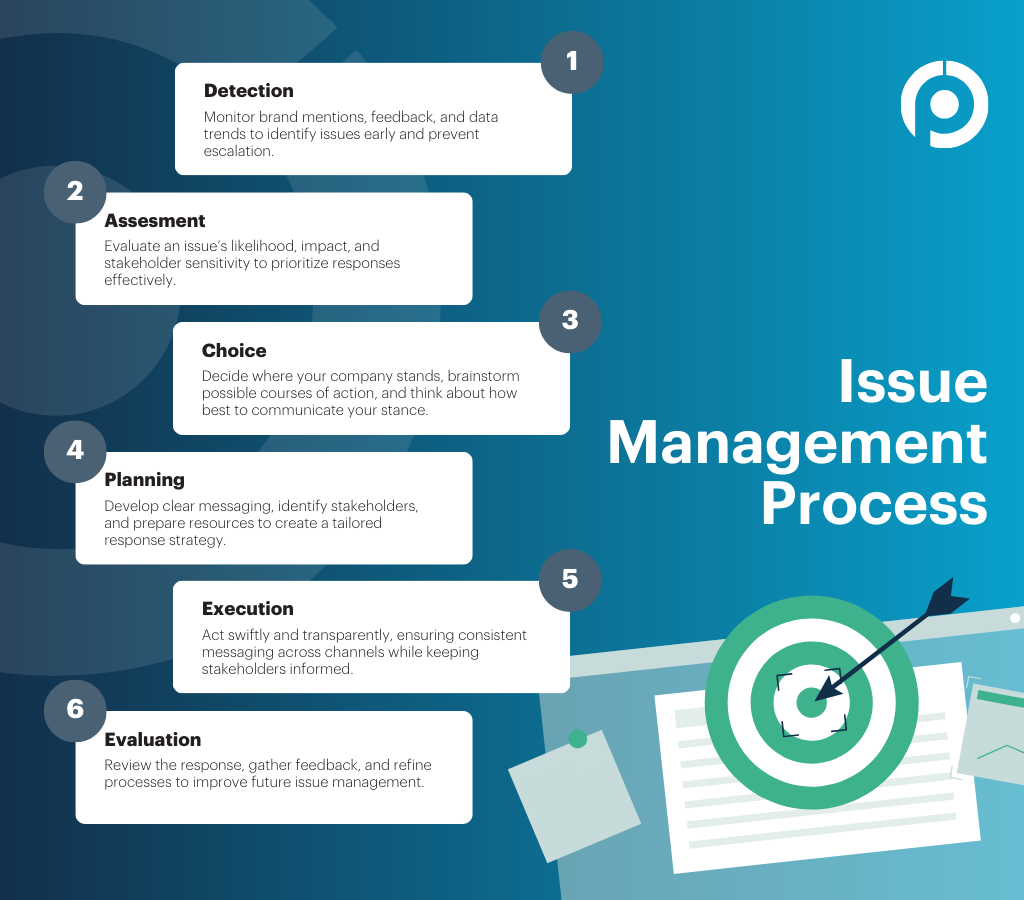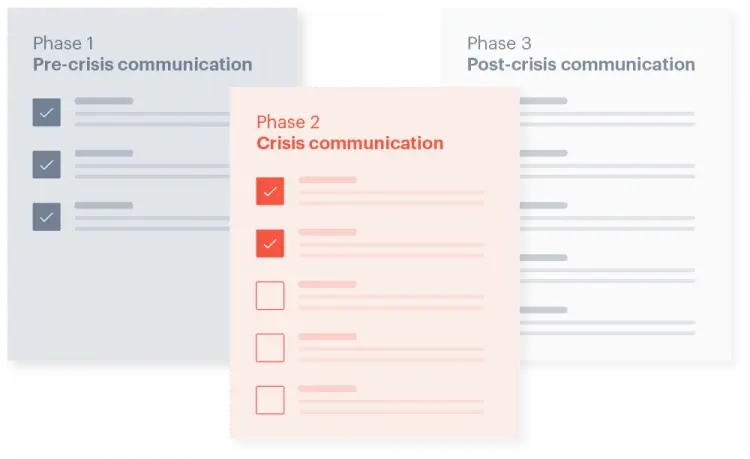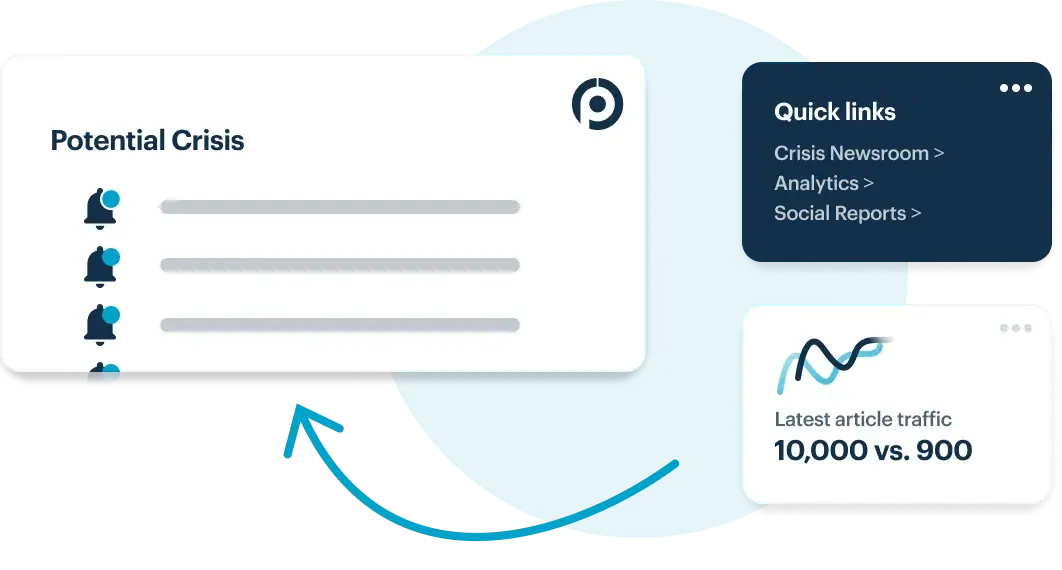Managing public perception is a critical part of running a successful organization. With information traveling so quickly, even small issues can snowball if left unchecked. But it’s not all doom and gloom—having the right tools and strategies in place means you can stay ahead, address concerns early, and even turn challenges into opportunities to build trust and strengthen your reputation.
This guide will take you step by step through creating a reliable, adaptable issue management process. By following these steps, you’ll help ensure your organization is ready to handle anything that comes its way and emerge even stronger.
What is an Issue Management Process?
An issue management process is a structured, systematic approach to identifying, assessing, and addressing potential issues before they escalate into crises. While it’s crucial for responding effectively when problems arise, issue management is equally about being proactive—spotting potential challenges before they fully emerge and putting solutions in place to address them preemptively.
With a good issue management process in place, organizations can anticipate risks and act early. Addressing needs—like introducing a feature before customers request it—avoids problems and builds trust and loyalty.
At its core, issue management empowers organizations to maintain control in difficult situations while also demonstrating their ability to stay ahead of the curve. Here are some examples of where an effective process comes into play:
- Negative online reviews: Customers share feedback about your product or service on social media, providing an opportunity to improve and engage with your audience.
- Employee dissatisfaction: You learn that employees are dissatisfied with company policies or working conditions, prompting proactive changes to improve workplace culture.
- Emerging competitor threat: A new competitor gains attention in your market, encouraging you to innovate and differentiate your offerings.
- Regulatory updates: Upcoming changes in industry regulations are identified early, allowing you to adapt processes and maintain compliance.
- Supply chain delays: Non-critical delays in your supply chain arise, giving you the chance to improve logistics and communication with stakeholders.
- Environmental opportunities: Increased audience interest in sustainability inspires a campaign to position your brand as a leader in your industry’s sustainability transition.
Issue vs. Crisis: What’s the Difference?
Issues and crises may seem similar, but they are distinct concepts that require different approaches.
In a nutshell:
- Issues are potential problems that could negatively impact an organization’s reputation if left unaddressed. For example, negative comments about a delayed flight or poor customer service on social media signal an issue.
- Crises, on the other hand, are urgent, high-stakes situations requiring immediate action, such as a major technical failure grounding an entire fleet or an in-flight safety incident.
 In more detail:
In more detail:
Crisis management is a reactive process focused on addressing severe, high-stakes situations like scandals or disasters. These scenarios demand urgent action, often before all the facts are clear, requiring quick decision-making under pressure. The primary goal is damage control—mitigating harm to the organization’s reputation while maintaining clear and immediate communication with stakeholders through real-time tools.
In contrast, issue management takes a proactive and strategic approach, identifying and monitoring low-to-medium risks before they escalate. By focusing on long-term planning and prevention, organizations can develop informed, cost-effective responses that address stakeholder concerns early and preserve trust. Tools like content metrics and trend analysis are essential for detecting potential issues, enabling organizations to act swiftly. Importantly, not all issues are negative per se—some are opportunities for brands to form opinions and proactively enhance perception rather than simply protecting existing value. Impact-driven businesses like Patagonia and Ben & Jerry’s demonstrate how clear and well-communicated stances on issues can strengthen brand value and foster trust.
By differentiating between the two, PR professionals can allocate resources effectively, prioritize appropriately, and avoid reactive decision-making. Addressing issues early prevents escalation, reduces reputational risk, and builds stakeholder trust.
Specific Examples
Consider the difference between a brewing issue and a full-blown crisis in the airline industry:
Issue: An airline notices an increase in passenger complaints on social media about limited legroom in newly upgraded seats. This is an issue—it requires monitoring, customer outreach, and possibly re-evaluating design or communication around the seating changes.
Crisis: The airline experiences an incident where a flight is forced to make an emergency landing due to an engine failure. This is a crisis requiring immediate, transparent communication, coordination with aviation authorities, and a thorough investigation to restore public confidence.
Why Do You Need an Issue Management Process?
The stakes for reputation management have never been higher. With the global PR market projected to exceed $133 billion by 2027, organizations are investing more heavily in strategic communication. Yet, many PR professionals report challenges in navigating today’s fast-moving and complex media environment.
The Risks of Operating Without a Process
Without a structured issue management process, organizations face significant risks:
- Slow Response Times: Delays in recognizing and addressing issues can lead to escalation.
- Inconsistent Messaging: Misalignment across communication channels erodes credibility.
- Reputational Damage: Stakeholders, including customers, employees, and investors, lose trust in the brand.

The Benefits of a Robust Process
A well-designed issue management process not only mitigates these risks but also provides tangible benefits:
- Early Detection: Keeping tabs on tag management, media monitoring, and content metrics allows organizations to identify potential issues before they escalate.
- Clear Decision-Making: By having predefined protocols and frameworks, teams can respond with confidence and precision.
- Consistent Messaging: Maintaining alignment across internal and external communication channels ensures credibility and trust.
- Improved Stakeholder Confidence: Transparent, timely issue management reassures stakeholders that the organization is in control.
Sif Group’s proactive approach to public company communications
In 2016, Sif Group transitioned from a private, family-owned business to a publicly listed company on the Euronext stock exchange. With increased public scrutiny and the need for transparent communication, Sif Group proactively addressed potential reputational risks by enhancing its communication infrastructure.
Through the implementation of Presspage’s platform, they ensured timely and accurate dissemination of financial and corporate news to stakeholders. This forward-thinking approach positioned Sif Group as a company committed to transparency and stakeholder engagement, successfully transforming a potential issue into an opportunity to build trust and strengthen their brand in the public eye.
The Bigger Picture: Building Resilience
- Navigate complex challenges in our complex digital landscape.
- Build long-term stakeholder trust and loyalty.
- Protect and enhance their brand’s value.
By investing in an issue management process, PR professionals position their organizations for success in an unpredictable world.

How to Build Your Issue Management Process
Putting together a successful issue management process (or issue management lifecycle) is no small undertaking - each step is designed to anticipate, prioritize, and resolve potential problems.
Let's get into our detailed breakdown of how to get started...
Step 1: Identify and Monitor Potential Issues
The first step in issue management is early detection. To stay ahead, PR professionals must continuously monitor their organization’s internal and external environments for brand mentions, hashtags, and trends. This includes keeping an eye on:
- Social Media Activity: Use platforms like Brandwatch, Hootsuite, or Sprout Social to track mentions, hashtags, and trending topics related to your organization.
- Media Coverage: Use tools (like Presspage) to gauge public sentiment through tag monitoring and content metrics.
- Keyword Tracking: Use Google Alerts, Mention, Ahrefs
- Internal Feedback Channels: Analyze customer service logs, employee feedback forms, and Net Promoter Scores (NPS) to identify patterns.
Regular monitoring enables teams to catch small problems before they snowball. For instance, negative feedback about a new product on social media can be addressed swiftly, preventing wider public dissatisfaction.
Pro TipsImplement a centralized dashboard that aggregates insights from various monitoring tools and schedule regular reports—weekly or biweekly—to identify patterns and emerging concerns. |
Step 2: Assess Risks and Prioritize Issues
Not every issue requires immediate action. Use a risk assessment framework to evaluate:
- Likelihood: How probable is it that the issue will escalate?
- Impact: What’s the potential effect on your organization’s reputation, revenue, or operations?
- Reputation Sensitivity: How sensitive is your audience to this particular issue?
By scoring each issue based on these factors, you can prioritize effectively. Low-priority issues might require monitoring, while high-priority ones demand immediate action.
RISK FACTOR |
LOW |
MEDIUM |
HIGH |
| Likelihood | Rare | Possible | Likely |
| Impact | Minimal | Moderate | Severe |
| Reputational Sensitivity | Negligible | Noticeable | Significant |
Pro TipUse a cross-departmental approach to ensure diverse input on prioritization. For instance, marketing may have insights on public sentiment, while customer service could highlight recurring client frustrations. |
Step 3: Establish Your Position
With priorities identified, it’s time to decide where your organization stands. Determine your stance on the issue, brainstorm actions, and consider the tone of stakeholder communications.
Example:
Your company identifies that an upcoming collaboration could spark backlash due to a recent controversy involving the influencer you’re working with. The partnership isn’t live yet, but the public is aware it’s on your radar, so there are several paths you could take:- The ‘hold the course’ path: You could reaffirm your support for your collaboration partner and highlight shared values.
- The ‘wait and find out’ path: You could pause or terminate the partnership, acknowledging stakeholder concerns.
- The ‘hope no one asks’ path: You could release a statement that focuses on your brand’s values without commenting on the partnership directly.
Pro TipsRemember to align your stance with your core values and weigh stakeholder needs and potential reactions. |
Step 4: Plan Your Response
Once an issue is prioritized and you've chosen your stance, it's time to create a tailored response plan. This plan should include:
- Key Messages: Clear, concise statements aligned with your brand’s tone.
- Spokespeople: Pre-designated team members trained to address media inquiries.
- Stakeholder Mapping: Identify internal and external stakeholders who need to be informed.
- Channels: The platforms you will use to communicate (e.g., press releases, social media, internal memos).
Developing templates for common scenarios can save valuable time. These templates should include placeholders for details that can be customized to the specific situation.
Common Templates to Create:
- Social Media Apologies
- Internal Memos for Employees
- Press Releases for External Audiences
- FAQs for Customer Support Teams
Pro TipReview and update response templates quarterly to reflect evolving trends and organizational priorities. |
Step 5: Act and Communicate
Execute your response plan with speed and precision. Transparency and consistency are critical in maintaining trust with stakeholders. When communicating:
- Be factual and empathetic: Acknowledge the issue without being defensive.
- Address concerns directly: Provide solutions or a clear path forward.
- Provide regular updates: Keep stakeholders informed as the situation evolves.
For example, if a data breach occurs, an immediate public statement should outline the scope of the breach, measures taken to secure data, and how affected parties can get help.
Pro TipUse multimedia channels like video updates or infographics to simplify complex information and reach a wider audience. |
Step 6: Monitor Outcomes and Adjust
After implementing your response, monitor the outcomes to evaluate success. Key questions to consider include:
- Did sentiment improve across key platforms?
- Are stakeholders satisfied with the resolution?
- What feedback did you receive from internal and external sources?
Analyzing these insights helps refine your process, making it more robust for future issues. Consider conducting a post-issue debrief with your team to identify lessons learned and opportunities for improvement.
Pro TipLeverage analytics tools to measure the impact of your response and track recovery metrics over time. |
Leverage PR Software to Enhance Your Issue Management Process
Modern issue management requires more than just vigilance—it demands the right tools to help you stay organized, informed, and ready to act. PR software plays a critical role in improving the efficiency and effectiveness of your issue management strategy.
Here are three key features to look for:
1. Centralized Collaboration Tools
Streamline internal and external communication with centralized collaboration features. These tools allow teams across departments to share updates, provide input, and align messaging in real time. This ensures everyone stays on the same page, even in high-pressure situations.
Pro Tip:When monitoring an issue, such as negative social media chatter about a product, centralized tools can help marketing, customer support, and PR teams quickly align on a response plan. |
2. Real-Time Monitoring and Alerts
PR software equipped with real-time monitoring capabilities provides immediate insights into emerging issues. From social media mentions to media coverage, these tools help you spot potential risks as they develop and enable faster responses.
Pro Tip:Set up custom alerts for high-priority topics or brand mentions to ensure you're always informed when something significant occurs. |
3. Analytics and Reporting Dashboards
Understanding the impact of your response is just as important as addressing the issue itself. Analytics dashboards track sentiment, engagement, and other KPIs, allowing you to measure the effectiveness of your actions and refine your strategy for future situations.
Pro Tip:By reviewing detailed reports post-issue, you can identify trends, determine what worked well, and pinpoint areas for improvement in your process. |
Why It Matters
Integrating these features into your issue management workflow ensures faster response times, improved coordination, and better decision-making. With PR software like Presspage at the core of your strategy, your organization can confidently navigate challenges while preserving stakeholder trust.
Conclusion: Build Resilience with a Strong Process
Creating an effective issue management process isn’t just about managing risks—it’s about building resilience and trust. By proactively identifying issues, assessing risks, and responding with clarity, PR professionals can protect their organization’s reputation and navigate challenges with confidence.
To stay ahead of potential issues and ensure your team is equipped with the right tools, request an online demo of Presspage’s PR software today. Learn how our solutions can support your issue management strategy and help you excel in a dynamic communications environment.
Want to get ahead of your PR issues? We’ve got you covered.
Grab a free online demo of our best-in-show PR software today!





